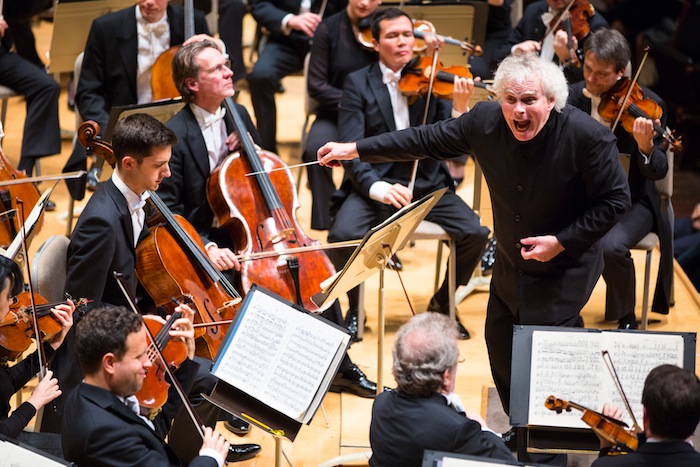Rattle, Berlin Philharmonic showcase their remarkable partnership with Boulez, Mahler
Pierre Boulez left an indelible mark on the Berlin Philharmonic. The orchestra frequently hosted him as a guest conductor and performed many of his most difficult scores.
Simon Rattle, who finishes his tenure as conductor of the Berlin Philharmonic at the end of the 2017-18 season, understands Boulez better than most. He has recalled Boulez’s probing mind and frankness about how he treated composers whom he deemed inferior during his early years as a champion of the avant-garde.
Boulez was aggressive in his artistic views, and his works are unapologetically complex. Friday night at Symphony Hall, the Berlin Philharmonic paid tribute to Boulez through a colorful performance of his Éclat. The Celebrity Series event marked Rattle’s final Boston appearance with the orchestra.
The work, scored for chamber ensemble, dates from 1965 when Boulez began experimenting with controlled chance procedures. All music is an event, but Éclat is literally so. Performers are given several parts that are to be played at certain points. But the conductor is solely in charge of the order, and, in essence, becomes the composer.
The piece unfolded episodically in sheets of instrumental color. A crash of piano figures dissolved into a whisper of notes from the winds. Disjointed phrases from the xylophone, percussion, guitar, mandolin, and cimbalom left a cloud of harmonics hanging in the air. When the winds and string entered, the musicians performed passages of pulsing energy.
Rattle’s job was less a conductor’s than a traffic cop who pointed out cues. But the performance he drew was bold and committed.
The bulk of the program was dedicated to an incredible and vital rendition of a work from another composer-conductor.
Completed in 1905, Mahler’s Symphony No. 7 is a dance of darkness and light. The martial brightness of the outer movements recalls the First Symphony, and the night music in the inner movements manages to bustle with an intensity that sets the work apart from the bare tragedy of the Sixth.
Rattle has a firm sense of Mahler’s work and its many details, leading the chamber-like dialogue between the instruments of the orchestra with a fine ear. The Berlin Philharmonic is one of the greatest orchestras in the world and is capable of playing with both precision and bracing intensity. Strings and winds played with gleaming sound and a delicate intimacy that still managed to come across in the fuller sections of the score.
In the first movement Rattle conjured a cloud of dark sonorities from the low strings and winds. The tenor horn solo cut through like a knife. The blustery march that makes up this movement is a barking and at times sarcastic one that seems to look forward to Shostakovich. Its passages were drawn out in paragraphs of sound as Rattle took listeners inside the piece.
The soft sections were particularly intimate. The second and fourth movements are labeled “Nachtmusik.” The burbling wind figures of the former created an effervescent texture, and Rattle coaxed a forest of sounds that ranged from radiant horn calls, shimmering strings, and dusky basses. They are a picturesque walk through the night, full of sweeping melodies and soft colors. Rattle and the orchestra gave readings of delicate grace.
The Scherzo was shot through with a Viennese lilt. Mahler long admired the work of Johann Strauss, Jr. and Franz Lehár, and the movement captures the sly, impish character of the lighter sides of their music. The movement’s waltz-like theme was crafted with swaggering rubato.
The finale culminated in phrases of glorious sound, with trumpets sounding round and full in the main theme. The inner sections of this movement sparkled with clarity, and when the principal theme returned, Rattle and the orchestra highlighted its transformation. Sometimes it was bold and brassy, in others broad and sweeping. At piece’s end the theme broke into bright fanfares, which brought the symphony to a rousing conclusion. For Rattle, it was the beginning of a grand farewell.
The Celebrity Series presents the Emerson String Quartet in music by Mozart, Ravel, and Shostakovich 3 p.m. November 20 at Jordan Hall. celebrityseries.org; 617-482-6661
Posted in Performances






Posted Nov 12, 2016 at 3:03 pm by Richard Riley
The Boulez piece was refreshingly obscure from the typically stale half-hearted musical fare. It was an unexpected musical gift of everything you always needed but unknown until you received it with perplexed joy, a hidden treasure unearthed for our pleasure. Magnifique!!!
The Malher symphony was truly surreal and other worldly. A deep yearning went unanswered but the journey was the key for life flows onward and the relief is found despite the challange ending.
Rattle is the heart of poetry who was our psychopomp in this quest last night. ” She walks in beauty like the night”.